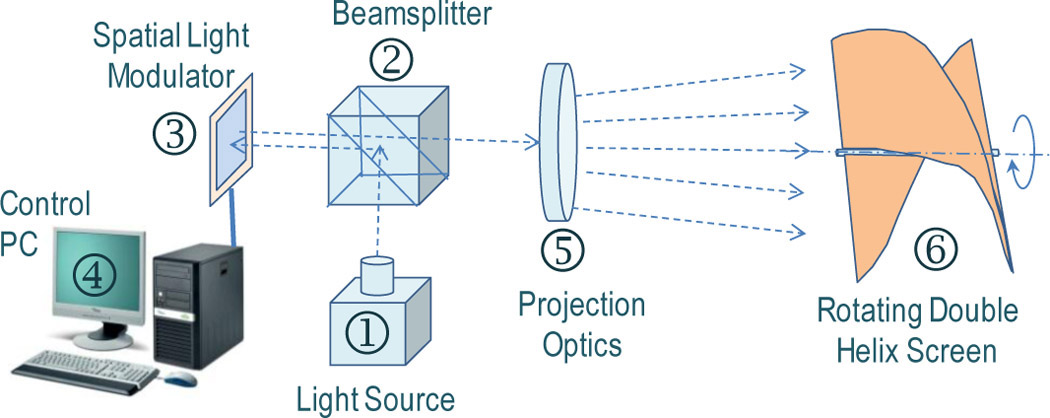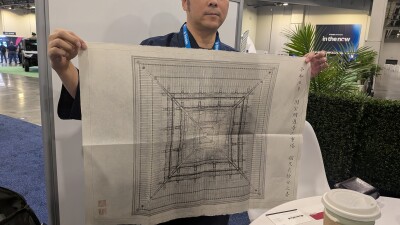This time, using a double helix
ROCKVILLE, Md. – A number of attempts have been made to develop 3D volumetric display, some based on holography, others on looking into a big black box of a television-like device. This month, on SPIE.org, researcher Jason Geng (VP for the IEEE ITS Society) put forward his current theory for bringing volumetric display to fruition: projecting image patterns onto a screen that is a rotating double helix.
Here’s the essential set up, as taken from the paper online:

And here’s the explanation of what you’re looking at: “Light from a source (1) is reflected by a polarizing beamsplitter (2) towards a spatial light modulator (3), whose image patterns are generated by a personal computer (4). Projection optics (5) make image patterns onto a rotating double helix screen (6).”
Currently, the system can display still and moving images in monochrome, such as this one:

Geng is working on color display.
But is this just theory turned into prototype for proof of concept, or is this something that might soon be commercially available? SPAR called Geng to find out.
“It’s in the development process,” Geng said, with a bit of a laugh. “There’s still a lot of technical difficulties that we need to overcome. It’s great progress, but there are a few developmental challenges.”
Partly, this is because Geng, who has received government grants over the years to work on everything from an ultra-miniature lidar device to a 360-degree video surveillance camera, sees the display as only part of an overarching capture-process-display system. “One depends on the other, they aren’t independent pieces,” he said. “And if we were to bring this technology to the marketplace, we would need to have all the parts, all the necessary component parts ready.”
There would need to be a uniform way for taking 3D data and preparing it for display, for example. Without content, the display is worthless.
He believes, however, that the system could be ready for commercial sale within five years. “It depends on the chain,” he said, “whether the content is going to be ready and whether we can find a killer application for it. If you really want to go to market, you need to find a real-world application where the technology really makes a difference. One thing about the display is that people get excited when they see it, but sometimes it’s hard to quantify the benefits.
“How much do you want to pay to go from 2D display to a 3D display?,” Geng asked. “That’s hard to quantify, so that’s the problem.”
In the meantime, others will look to similarly tackle the same problem, and not all of them essentially independent researchers. For example, Sony has developed a prototype of a 3D volumetric display, which it first demonstrated at Siggraph in 2010. If you haven’t seen it, this video shows some impressive capabilities, including the ability to play volumetric video games:
Unfortunately, no one has heard anything about this device since.
And finally, we’d be remiss if we didn’t pass along this video demonstrating the use of a number of synched Kinects to create a rough version of holographic video conferencing. They believe this could be commercially available in five years as well:





